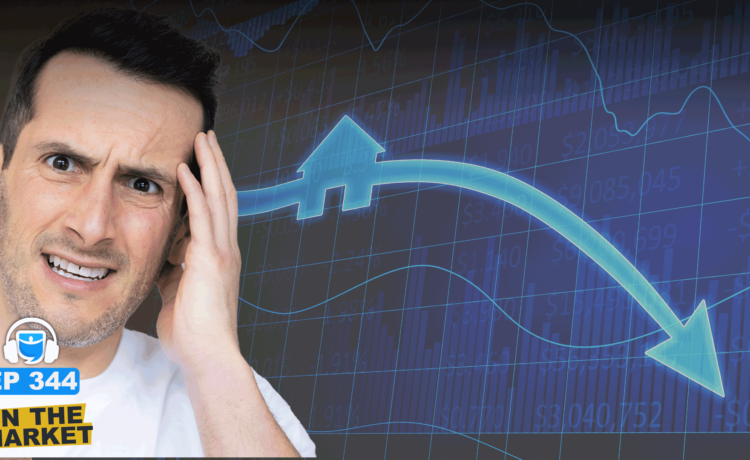Why are home prices finally falling? And how deep will the correction go? The number of large housing markets experiencing falling home prices has tripled since January 2025. ResiClub editor-in-chief Lance Lambert joins On The Market host Dave Meyer to break down why this widespread softening is happening now, how price dynamics are pushing more buyers toward new construction, and whether we’ve reached the bottom of the softening cycle. Lance also shares data on underwater mortgages and delinquency rates to forecast whether signs point toward a cyclical correction or a catastrophic crash.
Dave:
The number of large housing markets with falling home prices has tripled just since January, and the data says even more markets will follow in the coming months. Zillow has revised their nationwide home price projection down for the rest of 2025. This trend, of course, has huge ramifications for real estate investors and industry professionals. Today we’re going to dive into what’s happening in the housing market and how you can use these trends to your advantage in your own investing. Welcome back to On The Market. I’m Dave Meyer. Lance Lambert is back today on the show. He’s the co-founder and editor in chief of Resi Club. Lance is going to help us break down the expanding trend of softening home prices. We’ll dig into some intriguing data about single family home permits and his analysis of how far mortgage rates would need to fall to create the refinancing. Boom, I think everyone’s waiting for. Let’s dive in. Lance, welcome back to On the Market. Thanks for being here.
Lance:
Good to see you again. Housing, housing, housing. There is always so much going on in the US housing market, especially right now.
Dave:
I love it. Well, that gave me the intro I was going to do, but you already covered it for us. So for everyone who doesn’t know, Lance runs a website and newsletter called Resi Club, always looking at real estate data. So Lance, let’s just start with sort of the big headline that I think a lot of people are wondering about, which is home prices. We’re now seeing a lot of major forecasters downgrade their forecast for the year. What’s behind all of that and can you give us some details into how bad or good, depending on how you see it, things might get?
Lance:
Yeah, so I think the big thing here is that there’s been a widespread softening occurring in the housing market for a bit. And when you look at the nationally aggregated data right now, all of the major indices are seeing a deceleration in their rate of appreciation. So if you look in the data, you’re seeing this softening occur and it makes a lot of sense. The housing market has been coming out of the pandemic housing boom for a while in terms of rebuilding up active inventory, which during the pandemic housing boom, there was this huge influx of demand. The Federal reserve estimates that home construction would’ve needed to increase 300% to absorb all of that housing demand that came into the market during the pandemic housing boom. And the housing market wasn’t able to absorb all that demand housing starts did not increase 300%, which by the way isn’t even possible.
There are supply constraints, labor constraints just can’t happen. And so what occurred is that home prices overheated and they overheated in a historical fashion. And between March, 2020 to June, 2022, national home prices were up around 45% and some of the markets like Austin were up 70%. So it was just a really big runup at once. And then when the mortgage rate shock occurred, that affordability reality of home prices running up that much really set in. And so that’s kind of where we have been. And for a while some of these pockets of the country kind of stomached it, but as active inventory has built back up and those supply demand equilibriums have shifted, more of these markets have started to finally shift from sellers to balance, to balance to buyers. And even some of the pockets of Florida have felt like, especially in the condo market, strong buyers markets. So the housing market has been shifting as the market kind of recalibrates from prices just going up too quickly, too fast.
Dave:
Great summary, Lance. Thank you. There’s a lot to unpack there, but just back to the the headline about prices, why now we’ve been in this tightening cycle with higher interest rates for three years, people have been saying crash, people have saying it’s unsustainable. Why in 2025 are we starting to see this sort of across the board deceleration and appreciation rates?
Lance:
So if you want to think about it through an economic lens, you could even create a supply demand equilibrium chart. And on one axis you would have demand being sales and the sales side of it. You’re absolutely right. It really took a huge hit and a huge pullback in 2022 when we went into this mortgage rate an affordability environment. And so sales have been down there, but the other axis, and if you want to think about this as supply for inventory, active inventory that was still fairly tight when the affordability shock occurred. But now as that supply, that active inventory is slowly drifting up, that supply demand equilibrium is pulling more into a place that favors buyers. And so that’s occurred here is it’s just taken a long time for the market to kind get to the softened period. Now, I don’t want to act like things have been sunshine and rainbows the past three years. They have not. It’s been a very constrained housing market, very unhealthy housing market. But I’m just saying that we’ve worked into this place now where buyers are gaining more leverage and more of the markets are seeing falling home prices.
Dave:
Well thank you Lance. That’s a great national overview and I do want to dig more into some of these regional trends. Obviously we’re seeing this sort of split of the market, everything’s started slowing down, but performance is really dramatically different depending on where you are in the country. So let’s dig into those regional differences right after this break. Welcome back to On the Market. I’m here with resi clubs Lance Lambert talking about national home prices, mortgage rate trends. And before the break, Lance gave us a great summary of the national environment. Are there any other regional differences that you think we should know about and what is going into those sort of the dramatic differences between different regions and honestly even within different cities within the same state,
Lance:
We have been seeing for a while now a deceleration of softening buyers, gaining leverage. In a lot of the markets in the Sunbelt that have a lot of home building, a lot of new construction, those markets also tend to be migration destinations. And so during the pandemic housing boom, a lot of ’em like Tampa, Jacksonville, Austin, they sell prices run up even more. And so what that does is it creates a greater likelihood of a bigger demand shock once the affordability environment shifts. And so what Tampa and Austin saw is that once mortgage rates shot up, more of their demand was pulled back because so many of the local incomes couldn’t afford where prices got to.
And then the other thing is they had a greater vulnerability to a bigger demand shock because they saw so much net domestic migration coming in. A lot of Americans were moving to Tampa, Austin in 2021. And so while people are still moving to Florida, Texas, Arizona, the levels are not as high as they were during the pandemic housing boom. And so in Florida there was around 300,000 Americans on a net basis that moved in between summer July, 2021 and July, 2022. In the most recent 12 month period for July 23 to July 24, it was only 60,000 Americans on a net basis that moved in Florida.
Dave:
So still a lot,
Lance:
Still a lot moving in, but because you have fewer of those deeper pocketed buyers moving in, it creates the bigger demand shock because then you have to rely more on local incomes to support where prices got. And oh, by the way, I just mentioned prices in those markets ran up even more during the pandemic housing boom. And another factor here is that those markets have a lot more supply, a lot more new construction coming into the market. And that’s always the case. Those are the markets that are the epicenter a building in America, right? Dallas, Houston, those are the single family epicenters of home construction
And markets like Atlanta of course, and Charlotte and Austin. And so it’s not necessarily because so much supply was coming into the market and it’s more so that those markets have new construction, more of it. And so when the affordability environment shifts, builders are more likely to be aggressive on affordability adjustments to keep volume going, to keep sales going. Like Pulte group right now, they’re spending around 8.7% sales incentives per sale. And so in normal times they usually do three to three and a half percent. And last year at this time it was 6%, now it’s up to 8.7%. So on a $600,000 sale, which is their typical sales price, they are doing about $52,000 in sales incentives right now. And so what that does is it pulls some of the buyers who would’ve otherwise went to the resale and existing home market. And some of them are like, you know what?
These existing home sellers, they’re not really accepting reality of where we’ve gotten to, right? They’re stubborn, they’re fighting to keep every dollar their equity they have, and the buyer looks over at the new construction and they’re like, you know what? I wasn’t really considering new construction, but this payment that I would get through new construction is better for me than if I went to the existing home market. And so it pulls some of the buyers who would’ve naturally went to the existing resale market to new construction. And so the existing and resale has a harder time selling. And so that active inventory begins to build. So it’s not necessarily just this huge pipeline of supply coming in and the Sunbelt, it’s that they’re doing these affordability adjustments to continue to move product. And so that pulls some of the buyer who would’ve otherwise went to resale.
Dave:
This is a really unique dynamic right now where new construction is cheaper than existing homes in a lot of markets. And on top of that, you’re also getting incentives. Normally for our audience, people who are investing in real estate and rental properties, for as long as I’ve been doing it until last couple of years, you never consider buying new construction. But now it is really attractive. You could buy something that is under warranty, is going to have all the modern amenities, it’s not going to have the same level of maintenance and repairs as everything else, and it’s cheaper. It is a really compelling thing. So I think if investors are starting to think of it like me, I can see why normal home buyers are moving from the existing home sale market to the new construction market. And honestly, I hadn’t really thought about how that is playing out in the inventory element. That’s a really interesting perspective there.
Lance:
And at the end of their quarters, especially the Q fours, some of these builders have done some really big aggressive incentives and pricing cuts and a little bit of smoke and mirrors where the price cuts are actually bigger than people might realize. Looking at the sales price, and I’ve talked to a few investors who’ve been getting some of these bigger juicier deals late in the quarters from some of the builders. So if you flip it, a lot of these northeast and Midwest markets, they didn’t have the migration coming in. And so when net domestic migration decelerate, they weren’t affected. They didn’t see that affordability shock, and if anything, they were able to keep some of their residents who would’ve otherwise left.
And so when you think about something like the lock-in effect, which is people not wanting or not being able to afford giving up their lower monthly payment and rate for a higher monthly payment and rate the lock-in effect essentially takes away a buyer and a seller because they’re not selling their house and they’re not going out to buy that next property. But where that happens could be two different places. And so if somebody in Connecticut, New Jersey, Illinois, Indiana isn’t selling their house to go buy something in Florida to go buy something in Alabama and Texas, what that does is it takes away one home that would’ve been listed for sale in the Northeast and Midwest, but it takes away the buyer in the south. And so the lock-in effect is creating shocks to supply and demand, but the two places can be different. And that can even happen within markets where this neighborhood is not losing their sellers, but then this one’s not gaining that buyer. Right?
Speaker 3:
Yeah.
Lance:
Now one of the interesting things we’ve seen is that out west we have seen a greater softening over the past 12 months. And if you asked me where in the country has seen the fastest level of softening, it’s actually not the Sunbelt right now in terms of the southeast, southwest, those growth markets, those markets have been seeing a softening for a while it’s been occurring, but in terms of the fastest softening it’s been these western markets, and I’m not a hundred percent sure on all of the dynamics at play, some of it could be just that those markets have more strained affordability already. Some of it could be some of the softening that’s occurred in the tech job market. It could be some of that. I’m not a hundred percent sure on all of the dynamics that are at play out west, but I can tell you that they’ve seen a faster softening of late.
Dave:
Where does it go from here? Obviously everyone wants to know and you don’t have a crystal ball, but how do you see this playing out at least in the next year or so?
Lance:
So right now it looks like the direction is still pointing towards softening. If you look at the active inventory growth, if you look at what’s happened in these different markets across the country, the early leading data still suggest more softening to come. And I expect that to feed over more into the pricing data. But the question is are we at some point going to tighten up? And I think the answer is yes. I don’t think the speed of the softening is going to continue forever, but the answer that is really hard to nail down is how long of a period are we going to be in like this?
You could ask 50 different housing economists, 50 different housing analysts, and you’re going to get a lot of different answers on that one. But I think what is true is that the affordability environment we’ve been in, given that prices went up too fast too quickly, needs a bit of a healing here. We need the fundamentals to heal a bit. And so whether that’s rates coming down a bit, prices coming down a bit, incomes continuing to rise. And if you look at the data, we’ve had 30, 36 months of incomes outpacing national rent growth and home price growth. So there has been some healing occurring, but it’s a question of how much do we need to see? And so the things that I’m watching very closely continue to be months of supply, continue to be active inventory in these markets. And right now it’s pointing to still some level of softening. Now, I think people will point out that some of the markets, like in Florida, some of these markets that have seen prices fall, they are seeing active inventory begin to also fall now after the runup that we saw recently. But like I said before, that doesn’t necessarily mean that all of the softening is over. And you can use Austin, Texas as an example there. Austin, Texas has seen a seasonal rollover every year and it’s been in correction for three years. So watch active inventory, but also be careful not to misread it.
Dave:
I want to talk about new listings. I think that is also another really key indicator that we need to keep an eye out for. But we do have to take one more quick break. We’ll be right back. Welcome back to On the Market. I’m here with Lance Lambert. We’re talking about the direction of home prices and what’s just going on in the housing market nationally. Lance was talking before the break about active inventory and how we might know when a bottom is in One thing I’ve been watching, Lance, I’m curious your opinion on is new listings because I think you hear a lot of people who are pointing to a crash or saying that this is going to get really ugly and they point to new listings, which for everyone listening, there’s a difference between new listings and active inventory. New listings is the measure of how many people just put their home up for sale on the market.
Active inventory is how many homes are for sale at a given point in time. And that might sound similar, but it’s a pretty key distinction here because new listings is just a pure measure of supply. It’s just how much stuff is going on the market where active inventory is a measure of the balance between supply and demand, because active inventory can go down even if a lot of people are listing their homes because there’s buyers equal to that new supply and it goes off the market. One thing people point to is like, oh, new listings have been going up and they’ve been going up and up and up and up. But one thing I’ve noticed is that in the markets where you’re seeing the biggest corrections right now, new listings are starting to slow down. They’re not down from where they were last year, but that new listing pace is decelerating.
And to me that shows that this is kind of like a normal market cycle. Isn’t that what is supposed to happen when the conditions change and it becomes an adverse market for people to sell? You would expect to see new listings. And the reason I’m asking this is because to me that signals, yeah, I agree. I think we’re going to have a correction. I think a lot of markets are going to turn negative and it could last a while, but to me, this is a sign that gives me a little bit of confidence among other things that a full-blown crash is unlikely. And I’m just curious your opinion on that take.
Lance:
So I think my thoughts, there are obviously, and this is the part, this is my biggest disagreement with the really big bears for housing, is that there isn’t 2007 levels of distress in this housing market. No matter how you cut it, if you look at the single family delinquency rates, you look at the distress, it’s just not what it was then it’s not correct. And actually single family delinquencies just came in this week. They actually fell a little bit. And so they’re still fairly low. And so what we’ve seen in this market is that the affordability is very strained and it is putting downward pressure on the market, but there isn’t distress there where sellers are having to exit their house. They’re a forced seller. Yes, you’re going to see some of that, and that’s always natural in the market, but you’re not seeing the big wave of distress. And that’s not me underplaying the softness. We are absolutely seeing a softening in the market. Affordability is very strained, but the underlying reason here isn’t because we gave a bunch of bad loans to people who could barely afford it.
It’s that we saw so much demand occur at one time during the pandemic housing boom that we saw prices just go up faster than they should have. Now in some of these markets where prices have fallen, some, we are seeing a rise in the number of people that are underwater nationally, 1% of homeowners right now are underwater compared to 23% in September, 2009, still fairly low. But in some of these markets like Cape Coral, it’s now up to 7%. Austin’s up to 4%. And if you subset it by vintages, Austin’s 2022 vintage, when its prices peaked is 18% or underwater, and then Cape Coral and some of these Florida markets, some of their 2324 vintages are up to like 20%, 23%, 24% underwater. But if you look at the 2021 vintages, it’s very few underwater
Dave:
If it’s fine, right?
Lance:
And we have a few different factors there. One of them is that most people have some level of down payment when they buy a house. And so it gives them a bigger buffer because being underwater means that your home’s value is less than the mortgage you have outstanding. It doesn’t mean that the home’s worth less than what you bought it for, it’s that you’re actually under the mortgage. And so most people have some level of equity buffer because of their down payment. And so usually to get a bigger percentage underwater, you need more material corrections than we’ve seen so far. And one of the other reasons that a higher percentage of people aren’t underwater at the moment is that a lot of the markets that have seen bigger corrections like Austin, Texas, down 23% according to the Zillow home value index from peak down 19% from peak, according to ICE’s home price index for Austin, is that Austin was soaring up. It went up 70% for home prices during the pandemic housing boom. And at one point it was up 40% year over year, and it literally just penciled up to the top and then quickly blew off 10%
In 2022. So there was a much smaller cohort that actually bought at the top. Oh, interesting. Whereas one of the problems for GFC is we went up and smacked into that top around 2005 and we sat there for a while and we had all these loan products that got more people to purchase and kind of juiced existing home sales beyond what they would’ve. And so those vintages were massive.
Dave:
That makes a lot of sense.
Lance:
And so far the vintages of the markets that have rolled over haven’t been that big. And that’s why even though Austin’s down 23% for home prices, only 4% of mortgages in Austin or underwater.
Dave:
One last thing I just wanted to add to people. I think people hear the word underwater and get scared, and it is a really unfortunate situation, not a situation you want, but for a crash to happen. We talk about this a lot, you need this element of forced selling and your house being underwater is not necessarily forced selling. What has to happen for forced selling is for people to stop paying their mortgage rates. That’s when things really start to get bad. And as Lance noted, the delinquency rate, which is what we track to really try and forecast if there’s going to be for selling that delinquency rate, Lance just said went down last month. It’s still up from its bottom, but it is a fraction. Literally, I think it’s about 10% of what it was during the great financial crisis. And so just want to keep that all in perspective. Even though the rise in underwater mortgages is concerning and something we should all keep an eye on, it is different from forced selling and delinquency rates.
Lance:
And that’s what I was kind of getting to is that just kind of like being honest. If I had to peel back the onion, are we seeing any types of signals that we could get some distressed sellers? And at the moment, delinquency rates are fairly low, the levels underwater are fairly low. You do start to get some of these submarkets where the numbers underwater are kind of rising, but even in those markets, you’re still not at this point seeing many distressed sales and foreclosures.
Dave:
Well, Lance, this has been fascinating. Thank you. I learned a ton from this conversation. We appreciate you being here.
Lance:
Thank you for having me. Housing, housing, housing. Happy to chat anytime and if people want to follow my work, they can go to resi club analytics.com, subscribe to the newsletter. I’m also on Twitter all the time at News Lambert, and I’ve been spending more time on LinkedIn as well.
Dave:
You should check it out. I discovered Lance from Twitter. I’m a subscriber to Resi Club. Very good information. Check it out. Thanks again, Lance. And thank you all so much for listening to this episode on the market. We’ll see you next time.
Help us reach new listeners on iTunes by leaving us a rating and review! It takes just 30 seconds and instructions can be found here. Thanks! We really appreciate it!
Interested in learning more about today’s sponsors or becoming a BiggerPockets partner yourself? Email [email protected].















